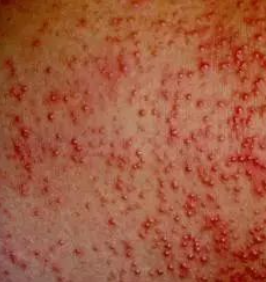
You notice them in the shower or while getting dressed—red, often itchy, and sometimes slightly raised patches in the sensitive skin of your groin or inner thighs. Your first instinct is to assume it’s a simple rash, perhaps from chafing or moisture. You might try a general anti-itch cream, hoping it will clear up on its own.
But when these patches are persistent, have a distinct border, and don’t respond to typical treatments, they are often more than a simple rash. These red patches in groin areas aren’t just rashes. They are very often a fungal infection, and the specific pattern is your body revealing the ideal breeding ground you’ve created for it.
This condition has a common name: Jock Itch (or Tinea Cruris).
Why the Groin? The Perfect Storm
Fungi thrive in warm, dark, and moist environments. The groin area is a perfect habitat because it’s a skin fold where moisture from sweat gets trapped, and there’s little air circulation. This isn’t about hygiene; it’s about environment. The fungus that causes jock itch is the same type that causes athlete’s foot, and it can easily be spread from your feet to your groin by a towel or your hands.
How to Tell It’s Jock Itch and Not Just Chafing
A simple friction rash is usually a generalized redness. Jock itch has a more specific signature:
- A Defined, Scaly Border: The edge of the rash is often very distinct, and may be redder than the center, with a slightly raised, scaly, or bumpy border. It can even look like a ring is spreading outward.
- Intense Itching or Burning: The itching is typically persistent and can be quite severe.
- Location: It primarily affects the groin, inner thighs, and buttocks, but usually spares the scrotum or vulva. A rash that prominently involves the genitals themselves is more likely to be something else, like a yeast infection or contact dermatitis.
What Your Body is Trying to Tell You
This persistent red patch is your skin’s way of sending a clear report on its environment. It’s saying:
- “This area is consistently too moist.”
- “We have an overgrowth of a fungus that naturally lives on the skin but is now out of control.”
- “My protective barrier is compromised.”
What to Do About It
The good news is that jock itch is highly treatable.
- Use an Antifungal Cream, Not Just Cortisone: This is the most important step. Over-the-counter antifungal creams containing clotrimazole, miconazole, or terbinafine are designed to kill the fungus directly. (Using a steroid cream like hydrocortisone alone can sometimes make a fungal infection worse by suppressing the immune response in the skin).
- Keep the Area Dry and Cool: This is just as important as the cream. After showering, dry the area thoroughly with a separate, clean towel. You can even use a blow dryer on a cool setting. Wear loose-fitting, breathable cotton underwear.
- Treat Your Feet, Too: If you also have athlete’s foot, treat it at the same time to prevent re-infecting your groin.
- See a Doctor If: The rash doesn’t start to improve after two weeks of over-the-counter treatment, if it keeps coming back, or if it becomes extremely painful, swollen, or starts to ooze. A doctor can prescribe a stronger antifungal cream or pill.
Those red patches in your groin are a message about balance. They indicate that the delicate ecosystem of your skin has been tipped in favor of fungus. By recognizing this signal and responding with the right antifungal treatment and lifestyle changes, you can restore balance, relieve the itch, and reclaim your comfort.